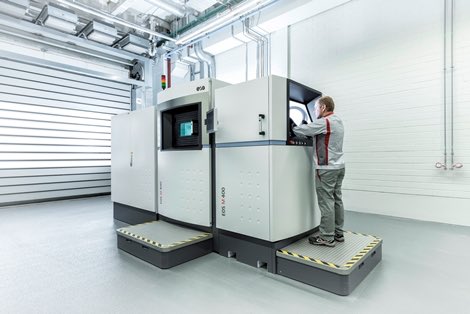Automaker Audi AG has launched a development partnership with additive manufacturing specialist EOS. The EOS Additive Minds consulting division will work with Audi on the implementation of 3D printing as well as the development of a 3D printing center in Ingolstadt, Germany.
“The aim is to not only supply Audi with the right additive systems and processes but to also support them during applications development, when building up internal additive manufacturing (AM) knowledge and training their engineers to become in-house AM experts,” said Güngör Kara, Director of Global Application and Consulting at EOS.
 Image courtesy of EOS.
Image courtesy of EOS.“We have set up our own competence center for 3D printing in order to gain experience with the materials and the process, and to further develop them for series production,” said Jörg Spindler, head of Toolmaking at Audi. “A close cooperation with AM solution providers such as EOS, who can support innovation in technology development, is essential for these aims. With this technology we are able to integrate internal structures and functions in tools that we have not been able to create so far with conventional manufacturing methods. Especially with components in small batches, we can now produce components using lightweight construction, quickly and economically based on this technology.
Audi first applied 3D printing to equipment and prototype building, and has deployed the technology in its motor sports division. Audi also plans to print inserts for die casting molds and hot working segments. According to an EOS press release:
“The company can positively influence the process of series production by conformal cooling, producing parts and vehicle components more cost-effectively. This is made possible by using highly complex, additively manufactured cooling channels, which are tailored to the component and could not be implemented conventionally before. Specifically, the optimized cooling performance leads to a reduction of the cycle time by 20 percent which has a positive effect on the energy consumption and cost efficiency of the components at the same time.”
Audi is also collaborating with SLM Solutions Group AG, using the selective laser melting process to create both prototype parts and spare parts. For example, Audi manufactures the water adapters on the Audi W12 engine on demand using an SLM 280 machine.
“Manufacturing on demand is a vision for us to ensure supply with original spare parts, which are required less often, economically and sustainable in the future,” said Dr. Alexander Schmid, after-sales manager at Audi AG. “
Audi sees a benefit both in the on-demand nature of additive manufacturing, as well as the ability to construct complex geometries.
“The new constructive freedoms provided by this technology are especially interesting,” said Harald Eibisch, who works in the technology development department at Audi. “Components for prototypes and spare parts requested extremely rarely are better suited for SLM processes than conventional manufacturing procedures thanks to the benefits of free geometric design. The load capacity of the components is comparable with parts manufactured using traditional methods.”
Source: SLM Solutions and EOS
About the Author
Follow Robotics 24/7 on Linkedin
Article topics
Email Sign Up
















